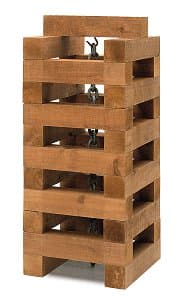

Carl Andre
Learn moreChain well 1964
© Carl Andre. VAGA/Copyright Agency Purchased 1979
More detail | PermalinkSince the 1960s Carl Andre has been recognised as a principal exponent of Minimalism, along with artists such as Donald Judd, Dan Flavin, Sol LeWitt and Robert Morris. Born in Massachusetts in 1935, after his studies he travelled to England and France, returning to serve in the army from 1955–56. He moved to New York in 1957 and in 1958 worked briefly in the studio of painter Frank Stella, where he made his first large sculptures in wood scavenged from neighbourhood building sites.
In 1960 Andre made a number of drawings for sculptures, which he called the Elements series, proposing to construct them from standardised wooden blocks in simple, regular configurations. Due to a lack of funds he could not realise the works, but his intention to use modular units in repetitive arrangements with theoretically endless possible variations was an approach that remained fundamental to his later work.
Andre was included, along with Judd, Morris and others, in a group exhibition in New York in 1965. He built a work, Well 1964/1970, using 28 heavy wooden beams stacked to create a solid wall over two metres high around an internal space. Well was dismantled partway through the exhibition due to the weight exerted on the gallery floor, however the beams were rearranged into another work that spread out the weight distribution, a three-tiered zigzag wall-like arrangement placed across the floor, exemplifying the modular quality of Andre’s work.
Also in 1965 Andre held his first solo exhibition, which included three large, although lightweight, works built from white Styrofoam beams in similar arrangements to the works built in wood. He also included a number of smaller pieces, described as ‘more practical objects’ by one critic[1], including Chain well 1964. It is almost unique among Andre’s work of this period in its combination of two seemingly disparate elements, principally the addition of a second material—the metal chain suspended through the centre of the stacked wooden blocks. It is now known that Andre was dissatisfied with Chain well, considering the chain an extraneous element, a pictorial feature that contaminates the essential process and resulting structure of the work.[2]
Many of Andre’s sculptures in the early 1960s were dismantled or destroyed after being exhibited and now exist only as later reconstructions. Chain well is one of the few works from this period to exist in its ‘original’ state, as the collector and museum director Larry Aldrich acquired it directly from the exhibition.[3] It is conceivable, given the artist’s later dissatisfaction with the piece, that had the work been destroyed after the show, it might never have been remade.
Michael Lloyd and Michael Desmond[4]
[1] Lucy Lippard, ‘New York letter’, Art International, vol 9, no 6, 20 September 1965, p 58.
[2] See James Meyer, Minimalism: Art and polemics in the sixties, Yale University Press, New Haven and London, 2001, pp 132, 293 n 61.
[3] Meyer suggests that Chain well was given to Larry Aldrich by Andre in return for sponsoring his first solo exhibition; see Meyer, p 129.
[4] Adapted and updated from Michael Lloyd and Michael Desmond, European and American paintings and sculptures 1870–1970 in the Australian National Gallery, Australian National Gallery, Canberra, 1992, pp 332–3, by Steven Tonkin.

